
तरल पदार्थों के मिश्रण और हलचल की मूलभूत समस्याएं तरल धाराओं के यांत्रिकी और उनके मिश्रण के साधनों से संबंधित हैं।
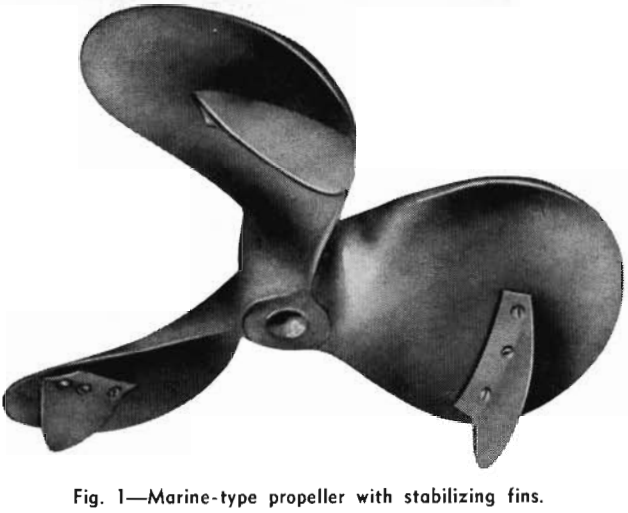
गति हस्तांतरण और अशांति के माध्यम से सामग्री हस्तांतरण द्वारा मिश्रण पूरा किया जाता है। हलचल अशांत द्रव गति का परिणाम है। अधिकांश बड़े पैमाने पर मिश्रण संचालन में, तरल प्रवाह उत्पन्न करने के लिए एक घूर्णन प्ररित करनेवाला का उपयोग किया जाता है। अशांति चार तरीकों से उत्पन्न हो सकती है: तरल पर प्ररित करनेवाला ब्लेड की क्रिया द्वारा; टैंक की दीवारों पर तरल के रगड़ने से; किसी अवरोध के चारों ओर तरल के गुजरने से; या कम वेग धाराओं के बगल में बहने वाली उच्च वेग धाराओं द्वारा। यह बाद वाला तंत्र प्रवाह-वेग असंततता को शामिल करता है और प्रोपेलर और टर्बाइन-प्रकार के मिक्सर द्वारा अशांति और हलचल के निर्माण में सबसे बड़ी एकल भूमिका निभाता है।
मिश्रण टैंक बेलनाकार होना चाहिए, जिसकी धुरी लंबवत हो, तल समतल, फैला हुआ या उथला शंकु हो सकता है। टैंक के व्यास के बराबर तरल की गहराई अच्छी प्रथा है, लेकिन दो व्यास जितना गहरा हो सकता है। बड़े टैंकों में तरल की गहराई कम हो सकती है, लेकिन अगर गहराई बहुत कम है तो अच्छा मिश्रण प्राप्त नहीं किया जा सकता है। चौकोर या आयताकार टैंकों से बचना चाहिए क्योंकि कोनों में पर्याप्त तरल गति सुनिश्चित करना अक्सर मुश्किल होता है।
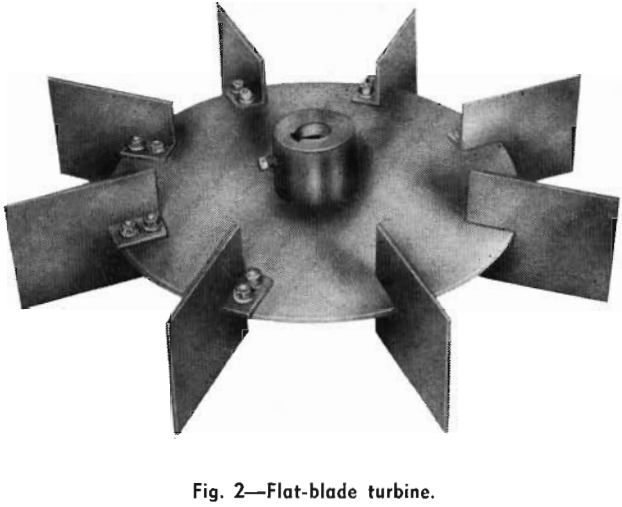

The impeller causes fluid motion and generates, together with the wall, the principal lines of flow through the liquid. When a single impeller of any shape or size is rotated on the center line of a smooth-wall cylindrical tank, the flow motion which is set up is a rotary swirling or vortex motion. The flow is circular and there is practically no vertical motion. The liquid moves as in a merry-go-round, and there is little chance for mixing because liquid is not forced sideways or vertically. If, however, there are obstructions on the wall of the tank or elsewhere, different impellers will give either of two different principal types of flow patterns. The marine-type propeller produces axial flow: the flow leaves the impeller in the direction of the axis of rotation. The flow pattern is illustrated in Fig. 4. It should be noted that there are vertical and lateral-flow lines: liquid is moved up, down, and horizontally, providing good top-to-bottom turnover, and this motion is conducive to good mixing. Note that propellers are almost always operated to discharge downward, and, when two are used on one shaft, they both discharge downward.
When flat paddles or turbines are rotated with obstruction in the liquid, the liquid moves from the turbines in a plane perpendicular to the axis of rotation. Such motion has been called radial motion, and any impeller which generates this type of flow is classed as a radial-flow impeller.
Ordinarily, impeller shafts enter through the top surface of the liquid, centered, and baffles are used. However, propellers can be used to give axial flow, top-entering without baffles, or side-entering without baffles, in off-centered positions.
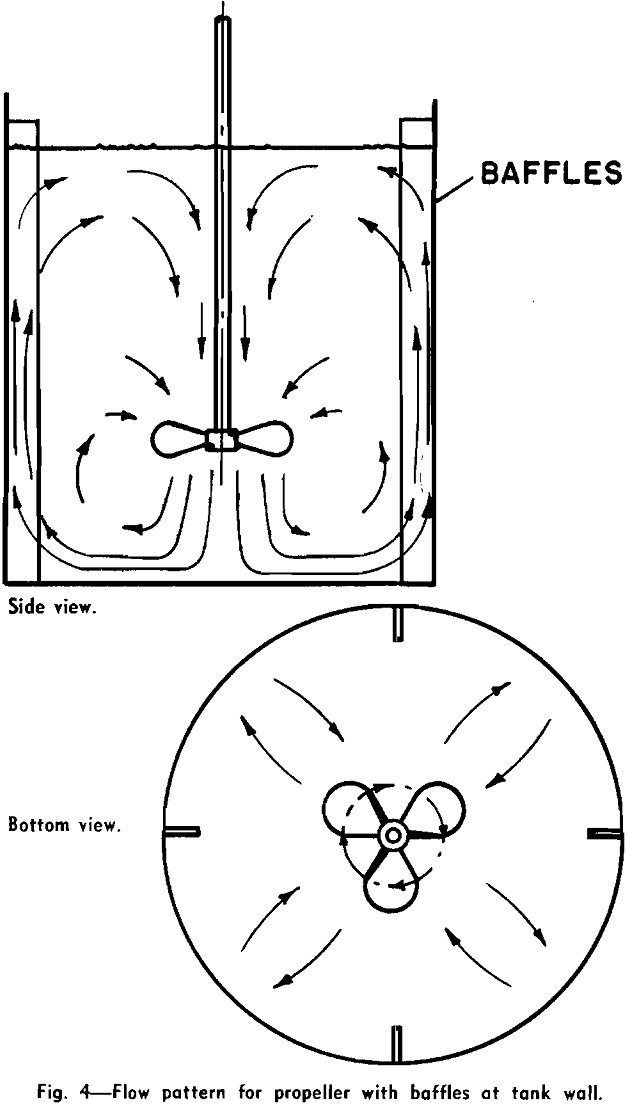
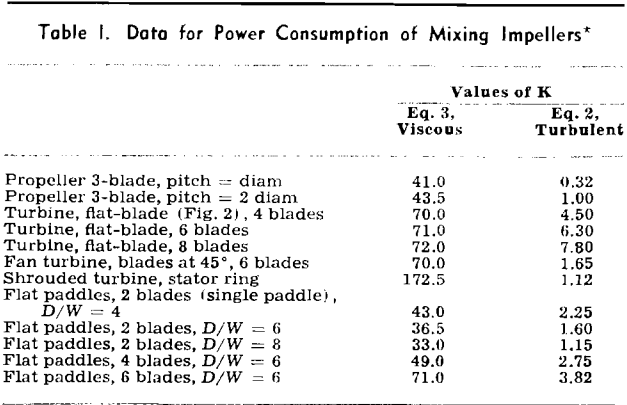
The first consideration for mixing in a process is the choice of the flow pattern best suited to the operation. If solids are to be suspended, vertical flow currents must be developed to oppose the settling velocity of the particles, as in Figs. 4, 5, and 6. Turbines and paddles are effective at low rotational speeds and are preferred for large tanks, since they permit the use of long shafts without submerged bottom bearings.
The power requirements for mixing depend upon the flow pattern desired, the velocities of flow which must be obtained at particular parts of the liquid, and the turbulent energy required. The velocity of flow is dependent upon the quantity of material in motion and the area through which it moves. Thus, a large quantity of flow produced by a small-diameter propeller will result in high velocities over small areas. Such flow will produce high intensity turbulence, but the scale of the turbulence may be low. On the other hand, low velocities of flow may be produced by a large-quantity flow produced by a large-diameter impeller.
Data are available for the flow produced in baffled tanks by square-pitch three-blade
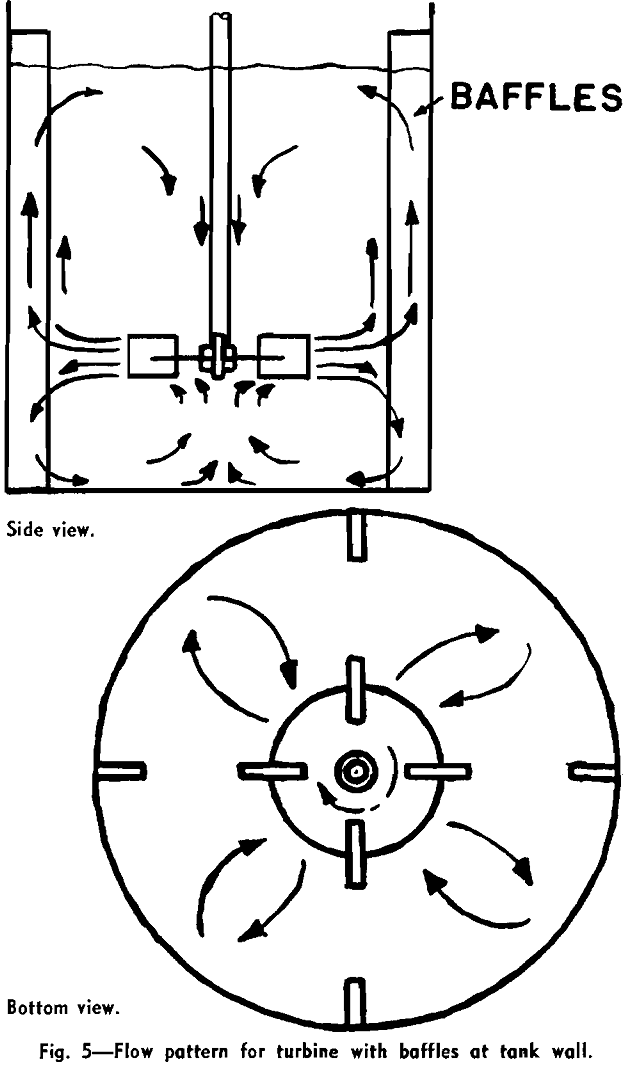
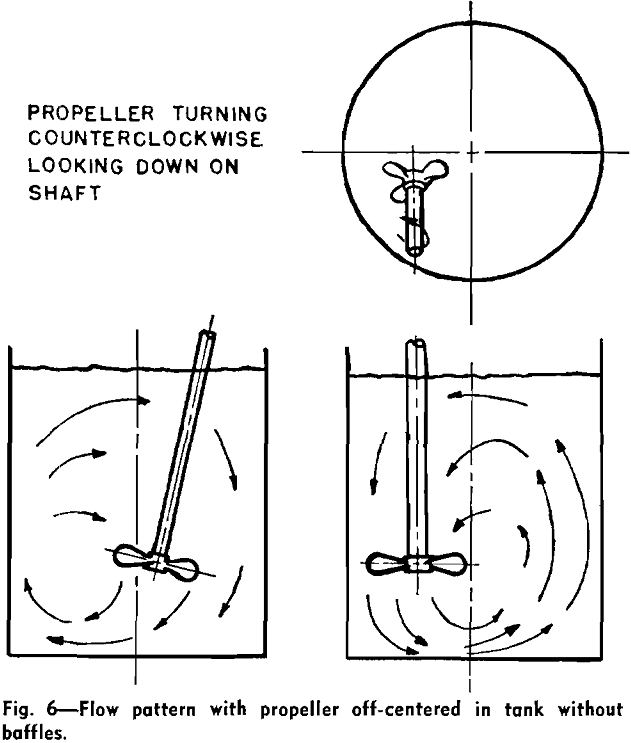
marine-type propellers manufactured by Mixing Equipment Co., Inc.,
Q = K N D³…………………………………………………………………(1)
जहाँ Q प्रति सेकंड घन फीट में प्रवाह है, N rps है, D प्रोपेलर व्यास, फीट है, और पानी के लिए स्थिरांक K 0.4 है। समीकरण दर्शाता है कि प्रवाह सीधे प्ररित करनेवाला गति और व्यास के घन के साथ बदलता है। यदि प्रोपेलर का आकार दोगुना कर दिया जाए और गति स्थिर रखी जाए, तो प्रवाह आठ गुना बढ़ जाएगा।
समीकरण 1 का उपयोग स्थिरांक K के उचित मान के उपयोग द्वारा चपटी ब्लेड वाली टर्बाइनों तथा अन्य आकार के प्ररितकों से उत्पन्न विक्षेपित टैंकों में प्रवाह के लिए किया जा सकता है। छः चपटी ब्लेडों वाली टर्बाइन के लिए K का मान, जैसा कि चित्र 2 में दिखाया गया है, 0.5 है।
प्ररित करने वाले यंत्रों को चलाने के लिए आवश्यक शक्तिएक घूर्णन प्ररितक को चलाने के लिए आवश्यक शक्ति उसके आकार, माप (D), गति (N), और स्थान, तथा द्रव के गुणों (घनत्व p और श्यानता µ), और टैंक फिटिंग और विन्यास पर निर्भर करती है।
जब (D²Np/µ) रेनॉल्ड्स संख्या का मान 5000 से अधिक होता है, और द्रव की सतह भंवर में नहीं घूमती है, बल्कि उसमें प्रवाह होता है, तो यह सुरक्षित रूप से माना जा सकता है कि द्रव की गति पूरी तरह से अशांत है। इन स्थितियों के लिए, शक्ति की गणना इस प्रकार की जा सकती है
पी = के/जीसी पी एन³ डी5……………………………………………………….(2)
जहाँ P प्रति सेकंड ft-lb में शक्ति है, gc गुरुत्वाकर्षण स्थिरांक है, और K एक स्थिरांक है (तालिका I देखें)। समीकरण दर्शाता है कि विक्षेपित स्थितियों के लिए, यदि किसी प्ररित करनेवाला की गति दोगुनी हो जाती है, तो उसे घुमाने के लिए आवश्यक शक्ति (2)³, या आठ गुना बढ़ जाएगी। साथ ही, यदि आयामी रूप से समान प्ररित करनेवाला छोटे वाले के आकार का दोगुना है, तो उसे छोटे वाले के समान गति से घुमाने के लिए (2)5, या 32 गुना शक्ति की आवश्यकता होगी।
चिपचिपी स्थितियों के लिए, जब रेनॉल्ड्स संख्या 10 से कम होती है,

प्ररितक द्वारा लगाई गई शक्ति के परिणामस्वरूप कुल शीर्ष के विरुद्ध प्रवाह होता है
पी = क्यू पी एच…………………………………………………………………………[4]
जहाँ H कुल हेड (फुट में) है, तथा इसमें सभी स्थैतिक, दाब, वेग, तथा अशांत हेड शामिल हैं। प्ररित करनेवाला से निकलने वाली धारा में आरंभिक अशांति H के समानुपाती होती है; इस प्रकार, एक बड़ा प्रवाह तथा छोटा हेड (या अशांति) या बड़ा हेड (या अशांति) वाला छोटा प्रवाह उत्पन्न करने के लिए समान मात्रा में शक्ति लगाई जा सकती है।
उदाहरण के लिए, 420 आरपीएम पर संचालित होने वाला कुछ आकार का प्रोपेलर एक यूनिट हेड पर एक यूनिट प्रवाह उत्पन्न करेगा। यदि एक बड़ा इम्पेलर, जो पहले वाले के व्यास का 1.52 गुना है, संचालित किया जाता है, तो उसे समान शक्ति को प्रभावित करने के लिए 210 आरपीएम पर घूमना चाहिए। इसके परिणामस्वरूप प्रवाह में 74 प्रतिशत की वृद्धि होगी (Q = 1.74) और छोटे प्रोपेलर के साथ मौजूद हेड में 58 प्रतिशत की कमी होगी। इन संबंधों को समीकरण 2 से प्राप्त किया जा सकता है जिसके परिणामस्वरूप
एनआर = डॉ -5/3………………………………………………………….[5]
जहाँ उप-अंक r बड़े आकार और छोटे आकार के अनुपात को दर्शाता है। ये संबंध उचित मिश्रण और आंदोलन उपकरण के चयन और बड़े आकार के उपकरणों के लिए प्रयोगात्मक परिणामों के पैमाने के लिए आधार हैं।
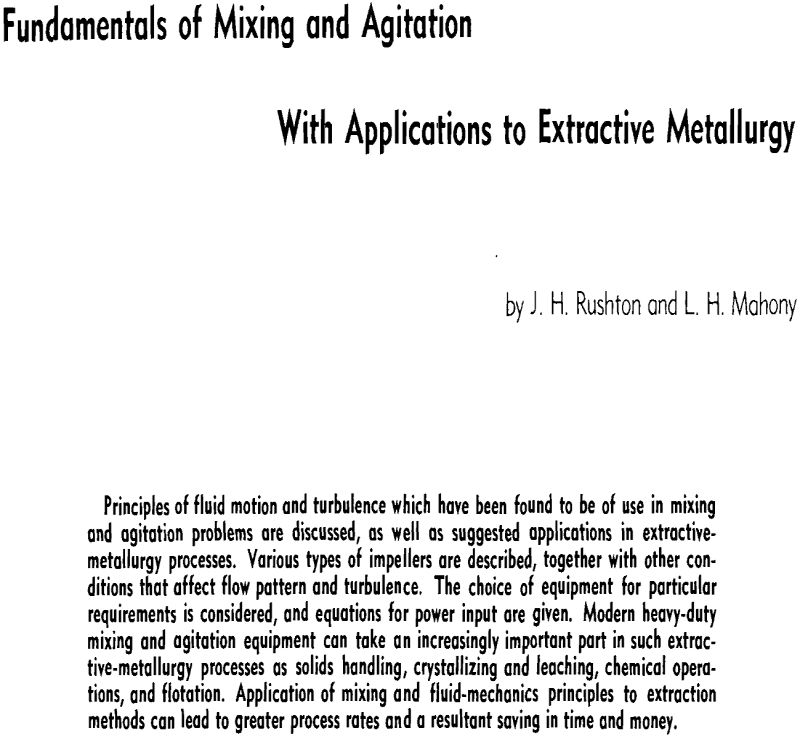
( मूल )